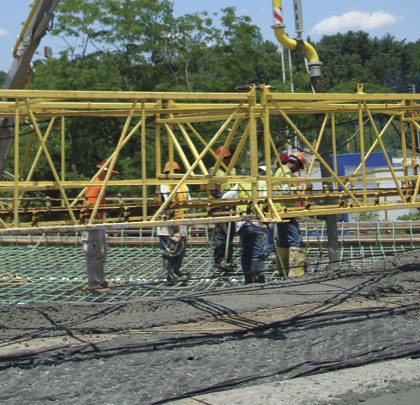The Federal Government spends billions of dollars annually on infrastructure projects, including highway construction and reconstruction, approximately $40 billion of which goes to state departments of transportation. As part of the U.S. Department of Transportation’s (DOT) Disadvantaged Business Enterprise (DBE) program, each recipient of federal financial assistance (e.g., state DOTs) is required to set goals for participation of disadvantaged entrepreneurs and certify the eligibility of DBE firms to participate in DOT-assisted contracts. The Federal Government’s generosity to the states is increasingly accompanied by significant oversight and scrutiny of the DBE participation on federally-assisted projects. This attention is focused on the contractors, subcontractors, and manufacturers performing the work and less on the state agencies setting the DBE participation goals and implementing the contracts.
The Federal Government has embarked on a journey to eradicate the “DBE Fraud” that it has found prevalent and engrained in the construction industry. As evidenced by recent federal investigations, and the resulting convictions and/or settlements, even well-established and experienced contractors have found that the climate has changed, and if they do not change course they may find themselves headed for significant tolls (e.g., hefty fines, penalties, and legal fees) or a dead end (e.g., suspension, debarment, or jail).
DBE PROGRAM AND REGULATIONS
Since 1983, the Federal Government has earmarked certain funds authorized for highway and transit federal financial assistance programs for DBEs. Numerous directives and mandates upon recipients of federal highway and transit funds are set out in the Code of Federal Regulations, Title 49, Part 26. The regulations may be boiled down to a couple of main components: (1) good faith efforts must be made to meet and maintain the stated DBE goal during the construction project; and (2) credit toward the goal may be taken only when DBE firms perform a commercially useful function. Many contractors have found themselves on a bumpy road because they either failed to perform a commercially useful function themselves or they failed to ensure that the entity with which they contracted actually performed a commercially useful function. Failures by both groups have resulted in severe penalties which beg the question: “What is a commercially useful function in the context of DBE contracting?”
26 CFR 26.55(c)(1) advises that “[a] DBE performs a commercially useful function when it is responsible for execution of the work of the contract and is carrying out its responsibilities by actually performing, managing, and supervising the work involved.” Conversely, 26 CFR 26.55(c)(2) instructs that “[a] DBE does not perform a commercially useful function if its role is limited to that of an extra participant in a transaction, contract, or project through which funds are passed in order to obtain the appearance of DBE participation.” Contractors should also be aware that the specific tasks to be performed by a DBE and the associated credit that may be taken toward meeting the DBE goal vary depending on whether the DBE is acting as a subcontractor, manufacturer, trucker, or supplier.
DBE FRAUD
The most common types of DBE fraud schemes are the “front scheme” and the “pass-through scheme.” In both cases, a DBE does not perform a commercially useful function as required by the government in exchange for its financial assistance.
The primary characteristic of the “front scheme” is typically the false representation of the ownership and/or control of a DBE firm. Under the regulations, to qualify as a DBE, the entity must be majority owned and independently controlled by a disadvantaged owner (e.g., a woman or racial minority), it must be “small” by the SBA’s size standards for the type of work to be performed, and must not have exceeded the limit on gross receipts set forth in the regulations. A classic front scheme occurs when, for example, a “women-owned business” is actually run and operated by a large company owned by the “woman’s” husband or brother. In such a case, both the woman owner of the “DBE” and the owner of the non-DBE company using the DBE as a front may be subject to prosecution.
In a “pass-through” scheme, the ownership is often not the issue, but rather the failure to perform a commercially useful function is at the fore. In this case, the pass-through or conduit company usually does little more than process paperwork, such as invoices for payment, while the work is actually performed by a non-DBE. As with the front scheme, both companies and all participants involved in a pass-through scheme may find themselves in hot water.
Contractors involved in fraudulent DBE-related schemes, or those that knew or should have known of such a scheme, on U.S. DOT-assisted projects are at risk for severe consequences, including: (1) invasive, disruptive, and costly investigations by, potentially, numerous federal and state agencies (e.g., U.S. DOT, State DOTs, FHWA, FBI, IRS, DOL); (2) criminal prosecution (typical charges include mail and/or wire fraud, conspiracy, obstruction, false claims, and false statements); (3) civil action (e.g., civil false claims); and (4) administrative actions that could result in suspension or debarment. Significant fines and penalties, forfeiture of contract proceeds, and jail time are also real risks for contractors found in violation of the DBE regulations.
HELPFUL TIPS FOR AVOIDING DBE FRAUD
- Carefully study the DBE program requirements and regulations
- Implement a compliance program
- Document the performance and provision of a commercially useful function by DBEs
- Conduct internal audits to ensure continuing compliance with DBE program requirements
- Implement in-house training for employees, including estimating and project management staff, to ensure compliance with DBE program requirements. ■
About The Author: Hanna Lee Blake, Esq., LEED AP, is a partner at Watt, Tieder, Hoffar & Fitzgerald, a top-ranked construction litigation law firm. Hanna focuses her practice on construction litigation and suretyship, representing contractors, owners, subcontractors, and sureties in all aspects of public and private construction projects. www.watttieder.com
_________________________________________________________________________
Modern Contractor Solutions, October 2015
Did you enjoy this article?
Subscribe to the FREE Digital Edition of Modern Contractor Solutions magazine.



